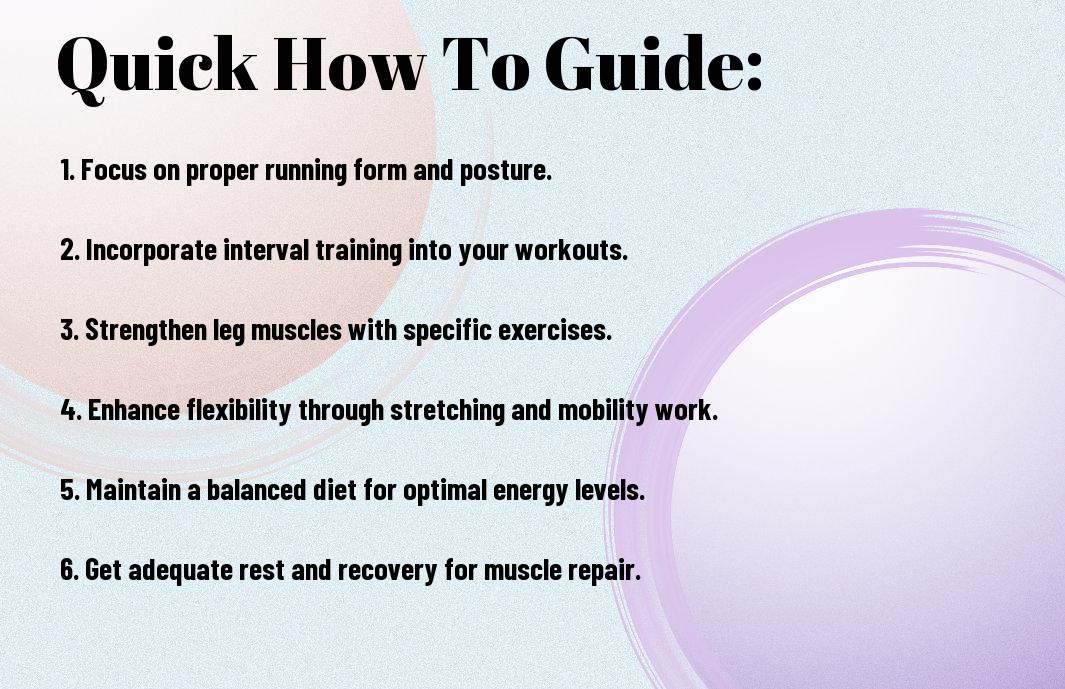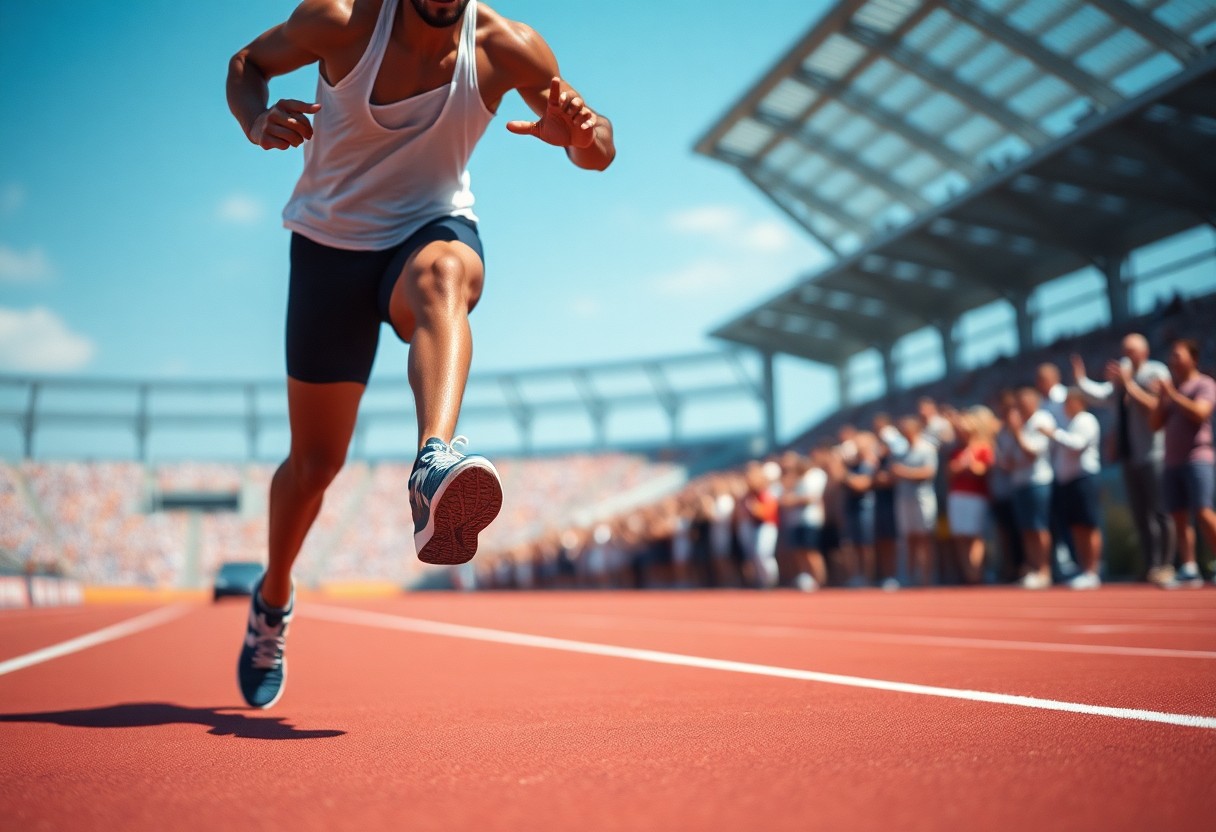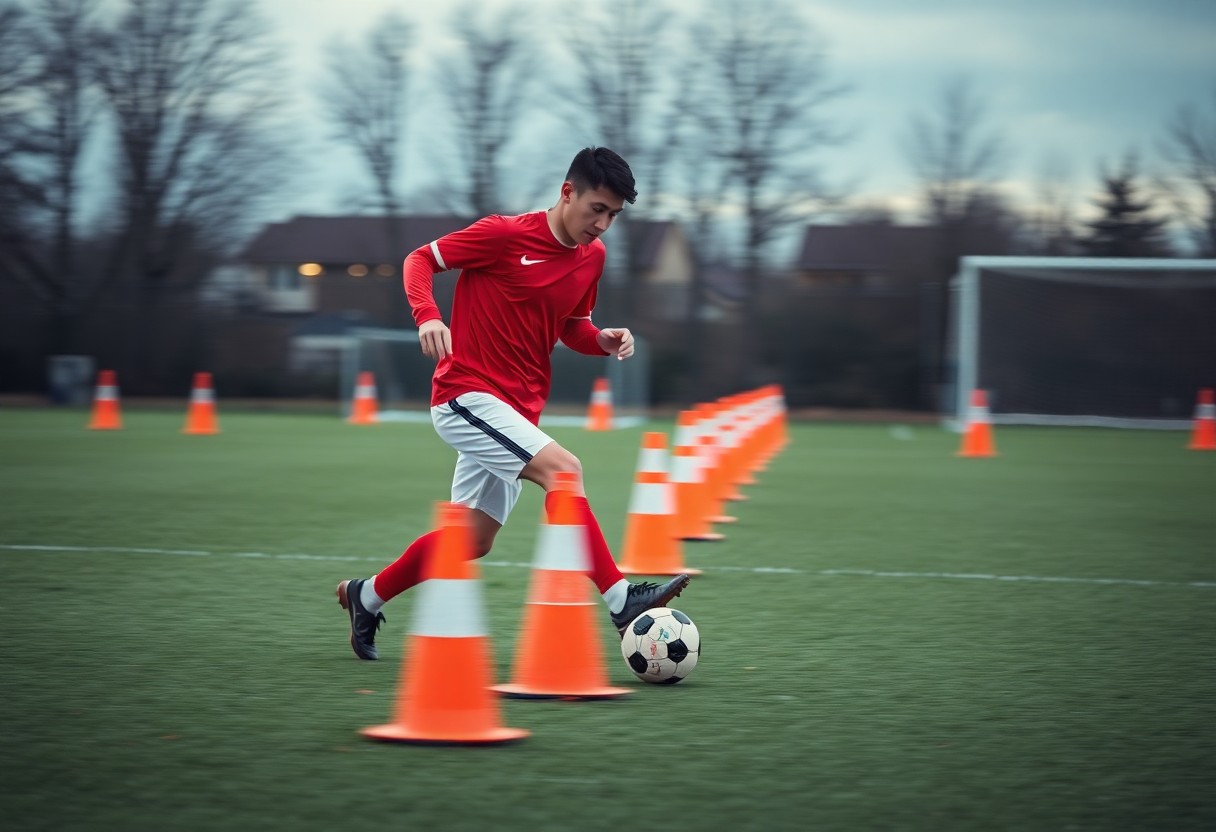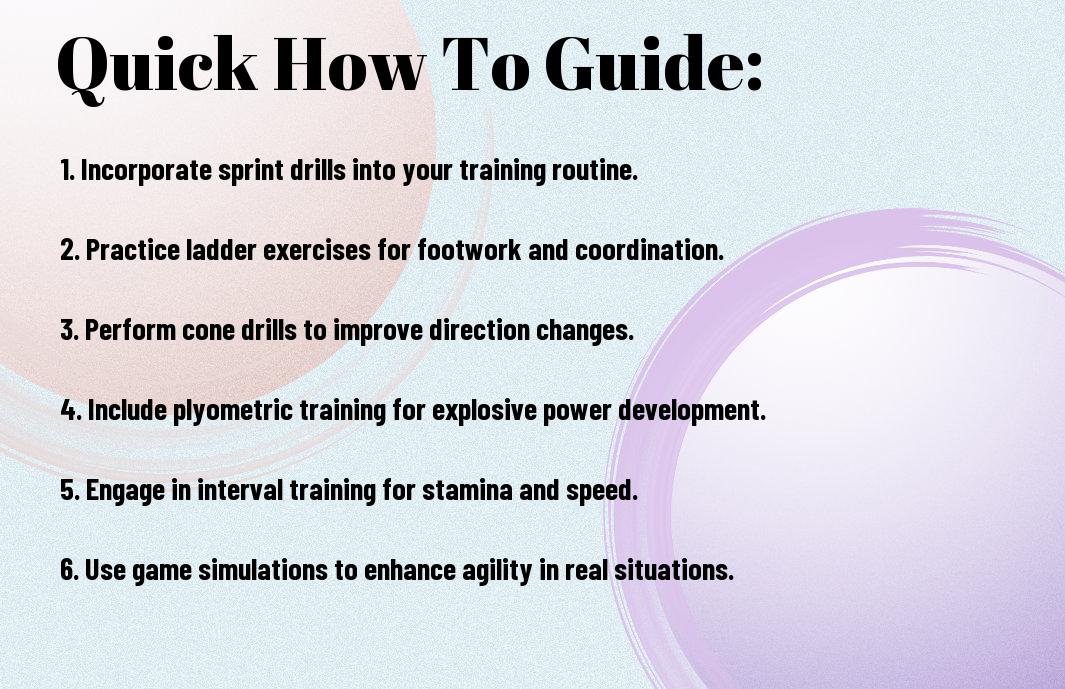Most athletes understand that speed and agility are key components of success in any sport. By focusing on specific training techniques and exercises, you can enhance your performance, whether you’re on the field, court, or track. This guide will provide you with practical tips and effective drills to help you increase your speed and agility, allowing you to outpace your competitors and dominate your game. Get ready to take your athletic abilities to the next level!
Key Takeaways:
- Dynamic warm-ups: Engage in dynamic stretching routines to prepare your muscles and enhance flexibility, which are important for optimal performance.
- Plyometric exercises: Incorporate jumps and explosive movements into training to develop power and improve your fast-twitch muscle fibers.
- Agility drills: Utilize cone drills, ladder drills, and shuttle runs to enhance foot speed, coordination, and overall agility on the field or court.
- Balance training: Include exercises that focus on balance and stability to enhance control and reduce the risk of injuries during quick movements.
- Nutrition and hydration: Maintain a balanced diet and stay hydrated to support energy levels and recovery, which are vital for speed and agility training.
Understanding Speed and Agility
As an athlete, understanding the concepts of speed and agility will provide you with a solid foundation for improving your performance in any sport. While both traits are often linked, they involve distinct skills vital for success on the field or court. Speed refers to your ability to move quickly in a straight line, while agility emphasizes your capacity to change direction with ease and control. By focusing on both, you can enhance your overall athleticism and competitive edge.
Definition of Speed
An vital component of athletic performance, speed is defined as the quickness of your movement from one point to another. It encompasses various factors such as stride length, frequency, and technique, allowing you to achieve maximum velocity during sprints and game situations.
Definition of Agility
There’s more to agility than just quick movements; it involves your ability to change direction swiftly while maintaining control and balance. This skill is vital in sports that require sudden starts, stops, and pivoting, allowing you to respond effectively to opponents and situational demands.
A well-rounded agility strategy includes drills that improve both reaction time and body coordination. These exercises should target various planes of movement—forward, lateral, and diagonal—to challenge your body in different ways. By incorporating agility training into your regimen, you enhance your sport-specific performance, ensuring you’re always a step ahead of the competition.

Key Factors Influencing Performance
If you want to enhance your speed and agility, several key factors come into play that can greatly influence your overall performance:
- Physical conditioning
- Nutrition and recovery
- Training techniques
- Proper gear
Recognizing these factors allows you to create a comprehensive plan tailored to your needs.
Physical Conditioning
One of the fundamental components for improving speed and agility is physical conditioning. A well-rounded fitness regimen that emphasizes strength, flexibility, and endurance will prepare your body for the demands of your sport. Incorporating exercises such as sprinting, plyometrics, and agility drills enhances your ability to move quickly and efficiently.
Nutrition and Recovery
The right nutrition and recovery protocols play a vital role in your athletic performance. Proper fuelling with the right macronutrients supports optimal energy levels, while adequate recovery allows your muscles to repair and grow stronger.
Factors like hydration, balanced meals, and rest days can significantly impact how your body performs. Committing to a diet rich in whole foods that provide important vitamins and minerals ensures your system is primed for intense training sessions. Incorporating post-workout recovery strategies, such as stretching and proper sleep, can further enhance your speed and agility gains, helping you compete at your best.

How to Train for Speed
Despite the multitude of factors affecting your overall speed, dedicated training can significantly enhance your performance. Focus on specific exercises and techniques that can elevate your speed, whether you’re on the field or in the gym. Consistency and proper execution are key for maximizing your results.
Dynamic Warm-Ups
Clearly, dynamic warm-ups are imperative in preparing your muscles and nervous system for high-intensity workouts. Engaging in a series of dynamic movements, such as leg swings, high knees, and butt kicks, raises your heart rate and improves coordination. This not only preps your body for speed training but also helps prevent injuries.
Sprinting Techniques
There’s no single technique for sprinting that works for everyone, but refining your form can substantially impact your speed. Focus on maintaining an upright posture with relaxed shoulders while driving your knees upward and landing on the balls of your feet. Practicing these elements will help enhance your efficiency on the track.
This can be achieved by incorporating drills like the A-skip and B-skip into your training routine. These exercises reinforce proper foot placement and body mechanics, which play an integral role in your overall sprinting technique. Additionally, consider recording your sprints for self-analysis or to share with a coach for valuable feedback.
Plyometric Drills
Train your fast-twitch muscle fibers with plyometric drills to improve your explosive power and acceleration. Exercises such as box jumps, broad jumps, and depth jumps help develop strength and agility, thereby increasing your overall speed. Integrating these drills into your routine can produce noticeable gains in your performance.
It’s imperative to focus on your technique when performing plyometric drills. Quality often trumps quantity, so aim for a few well-executed repetitions rather than numerous poor attempts. These explosive movements can enhance your muscle coordination and reaction time, making you faster and more agile in your sport.
How to Enhance Agility
Unlike speed, agility is the ability to change direction quickly while maintaining control over your body. To improve your agility skills, incorporating various training techniques is important. For additional insights, check out Speed and Agility – The How to for Everyday Athletes.
Agility Ladder Workouts
Enhance your footwork and coordination with agility ladder workouts. These drills consist of quick, explosive movements that focus on various patterns, building not just speed but also your ability to pivot and shift effectively during play.
Cone Drills
Cone drills are highly effective in improving your agility. By navigating through a series of cones, you practice swift directional changes that mimic real-game scenarios.
A great way to execute cone drills is by setting up various patterns, such as zigzags or T-shapes. As you run through these drills, focus on your foot placement and body control to simulate the quick movements required in your sport.
Reaction Time Exercises
One way to boost your agility is to incorporate reaction time exercises into your training routine. These activities force you to respond quickly to stimuli, enhancing your ability to react promptly in dynamic situations.
Plus, consider using tools like reaction balls, which bounce unpredictably, or practice partner drills where they give you sudden commands to change direction. These exercises improve your instincts, making you a more agile athlete on the field or court.
Tips for Incorporating Speed and Agility Training
All athletes can benefit from structured speed and agility training. To effectively integrate it into your routine, consider the following:
- Start with dynamic warm-ups to enhance flexibility.
- Incorporate drills like ladder drills, cone sprints, and shuttle runs.
- Focus on technique, ensuring proper form to prevent injury.
- Schedule training sessions on non-practice days to avoid burnout.
- Track your progress to motivate and adjust your routine as needed.
Thou can make significant strides in your performance with dedication.
Setting Goals
Goals should be specific, measurable, achievable, relevant, and time-bound. By outlining clear objectives for your speed and agility training, you can stay focused and motivated. For example, aim to improve your sprint time by a specific percentage within a set period. This targeted approach will help enhance your training efficiency and keep you accountable.
Balancing Training with Sport-Specific Skills
One of the biggest challenges in training is seamlessly incorporating speed and agility exercises with sport-specific skills. Strive to ensure that your training complements your sport rather than competes with it.
Another effective approach is to dedicate certain days to agility training while allocating others for skill development. For instance, you might focus on agility drills on alternate days, integrating them with sport-specific drills. This way, you maintain a balance that enhances both your overall performance and specific skills in your sport. By making these adjustments, you’ll see improvements in your game while minimizing the risk of overtraining.
Monitoring Progress and Adjusting Training
Not tracking your progress is a missed opportunity for improvement. By consistently measuring your performance, you can identify strengths and weaknesses in your speed and agility training. Utilize various methods like fitness apps, training journals, or wearables to gain insights into your growth. As you gather this data, you can fine-tune your workouts to achieve optimal results, ensuring you continue to enhance your athletic performance.
Tracking Performance Metrics
On a regular basis, it’s important for you to evaluate specific performance metrics, such as sprint times, agility drills, and recovery rates. These quantitative measurements will provide a clear picture of your progress and help you set realistic goals. By analyzing these metrics, you can determine which areas require more focus or adjustments in your training regime.
Making Data-Driven Adjustments
Adjustments to your training should be informed by the data you collect. Instead of relying on intuition alone, use the performance metrics you’ve tracked to guide modifications in your workout plan. This can include varying your training intensity, frequency, or rest intervals to target gaps and foster improvement. By making informed changes, you will maximize effectiveness and avoid plateaus in your performance.
Performance data not only highlights your progress but also uncovers patterns that may influence your training outcomes. For instance, if you notice that your speed gains stagnate after certain drills, consider integrating alternative exercises or recovery strategies that align with your goals. By treating your training adjustments as experiments grounded in data, you foster an environment for optimal growth and development in your speed and agility.
Final Words
Summing up, to enhance your speed and agility for any sport, focus on a balanced routine that incorporates plyometrics, sprint drills, and agility training. Pay attention to your nutrition and recovery, ensuring you fuel your body appropriately and allow it to heal. Consistency is key, so integrate these practices into your training regimen. By setting specific goals and tracking your progress, you’ll see improvements that will translate into better performance on the field or court. Commit to the process, and you’ll elevate your athletic capabilities significantly.
FAQ
Q: What are some effective drills to improve speed and agility for athletes?
A: Incorporating a variety of drills can significantly enhance speed and agility. Some effective exercises include:
- Acceleration Sprints: Short sprints of 10-30 meters focusing on quick starts.
- Ladder Drills: Use an agility ladder to perform various footwork patterns that enhance coordination.
- Cone Drills: Set up cones in different patterns (like T-drills or zig-zags) to practice quick changes in direction.
- Bounding: This plyometric exercise involves taking long, powerful strides to build explosiveness.
Incorporating these drills regularly into training sessions can lead to noticeable improvements in both speed and agility in any sport.
Q: How does strength training impact speed and agility performance?
A: Strength training plays a significant role in enhancing both speed and agility. By building strength in key muscle groups, athletes can generate more power, which translates to quicker sprints and faster directional changes. Focus on compound movements such as squats, deadlifts, and lunges that engage multiple muscle groups. Additionally, incorporating explosive movements like box jumps and kettlebell swings can improve fast-twitch muscle fiber activation, further boosting performance. A well-rounded strength training routine will not only improve athletic performance but also help prevent injuries by promoting muscular balance.
Q: What role does flexibility play in improving speed and agility?
A: Flexibility is vital for optimizing speed and agility. Improved flexibility allows for a greater range of motion, which can enhance stride length and efficiency during running. Dynamic stretching before workouts and static stretching after can help maintain and improve flexibility. Incorporating yoga or Pilates into training routines can also aid in flexibility development. It’s important to focus on hip flexors, hamstrings, and quadriceps, as these muscle groups are heavily involved in movements requiring speed and agility. Overall, a flexible body not only performs better but is also less prone to injuries.







